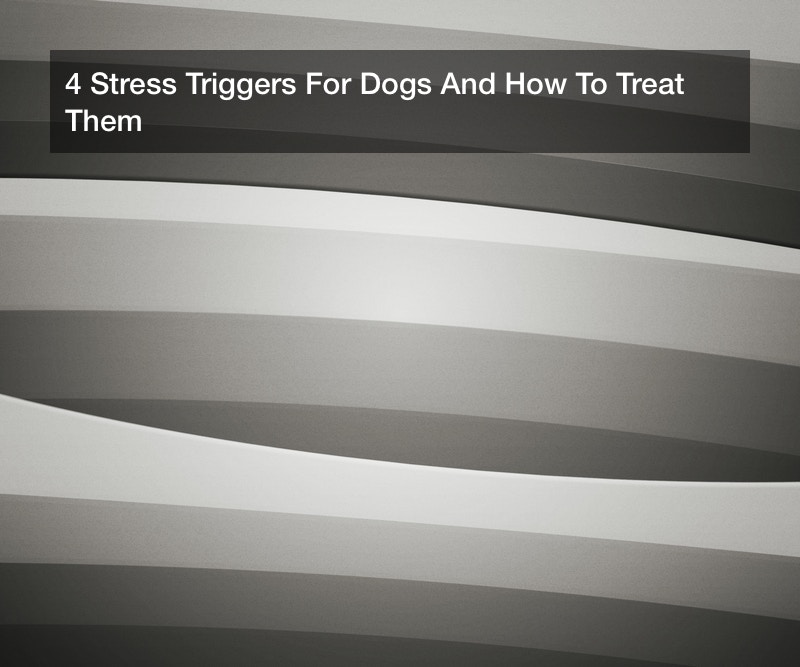

Pets are almost as an important part of American society as human beings at this point. It’s estimated that 67% of American households, totally around 85 million families, own some kind of pet, according to a survey conducted by the American Pet Products Association. This is actually a significant jump up from the first time the survey was taken in 1988; at that time, only 56% of households owned pets. Pets bring so much joy to our lives; it doesn’t so much matter what kind of pet you have, more so that you have one in the first place. Nonetheless, most people have a favorite kind of pet, and for the majority of Americans that is the dog. There’s a reason why they’re known as man’s best friends. Dogs are loyal, fun, and usually quite trainable. Most dog owners feel as if they have an emotional connection with their pet, which is why it can be all the more troubling when your dog isn’t feeling quite like itself. In fact, stress behaviors in dogs can lead to their human owners becoming more stressed in the long term. Nobody wants that!
There are many reasons why dogs become stressed, but their behaviors can become more severe and have further-reaching consequences than you might initially think. Stress behaviors in dogs can manifest vocally, with excessive whining or barking; they can also exhibit themselves in uncontrollable urination, with your previously housebroken dog leaving messes all over your hardwood floors. One particularly alarming example of stress behaviors in dogs is aggression. A lot of dogs that seem dangerous may not actually want to hurt people, but have become so stressed that they lash out defensively. It’s bad enough if your dog bites you. But a dog that bites someone else may have to be re-homed, or in the worst-case scenarios, sometimes even euthanized. Therefore, it’s important that you take your responsibility as a dog owner seriously and confront where these stress behaviors come from, and how they can be dealt with effectively. What are some of the most common causes of stress behaviors in dogs? Let’s find out.
1. Previous Owner Issue

There are so many benefits of rescuing a dog, and the majority of rescue dogs lack major behavioral issues that require an excessive amount of effort to overcome. However, some rescue dogs do have stress-linked habits that may be jarring when you first bring them home. Usually, these habits and behaviors are the cause of the previous owner. What you’ll want to look out for is the type of behaviors that swing strongly one way or another. It may seem cute that your new dog cannot leave your side, but it could be a sign that they’re actually stressed out, particularly if they’re whining to an extreme degree. Conversely, a lot of stressed-out rescue dogs may go to hide from their new owners. It can be difficult to tell at first whether or not behaviors like these are the result of simply being in a new home, or something ingrained and habitual.
There is a difference between truly aggressive behavior and simple barking. A lot of dogs bark, often quite loudly, so that their owners know that something is happening. This is why dogs tend to bark when a new person enters the home. The dog may have no intention of lashing out or attacking, but it wants its owner to be aware of the presence. If a dog is genuinely aggressive, they’ll be more likely to growl or snarl as well, and sometimes snap without warning. This type of behavior is often linked to abuse or neglect by former owners. If you adopt from a reputable animal shelter or rescue organization, you’ll be less likely to rescue a dog with such severe behavioral problems, at least not unexpectedly. However, you may end up taking a dog in unexpectedly, and whenever a dog has previous owners there’s the possibility of these types of stress behaviors being present. Stress behaviors in dogs can be difficult to treat, particularly when they’re linked to human beings. When your dog exhibits stress behaviors due to abuse or neglect, they’ll need to be very carefully socialized and gently eased into their new routines. You’ll want to work with a professional dog trainer, perhaps within the comfort of your own home at first. It’s important that you build trust with your new dog, and slowly begin to create a rapport. Perhaps the most important thing to remember is going at the dog’s pace. These types of dogs are not for newbie owners; nor are they always going to be great pets. But if you can, with the help of professionals, guide them to a place of trust you may very well have a friend for life.
2. Separation Anxiety

This may sound like a familiar story: you leave your dog so that you can go to work, only to return home and realize that your pet has chewed up your floors and furniture during your time away. Anxiety behavior is one of the most common types of stress behavior in dogs and usually manifests in destructiveness that occurs when you leave your dog home alone. This can lead to not only frustration but a variety of other problems. Your dog may very well end up having accidents around the house, another stress-linked behavior; it may also run the risk of eating something that it shouldn’t. You may have loved your Persian rug when you brought it into your home for the first time. But if your dog’s belly is full of fibers, you could end up spending thousands of dollars on the emergency veterinarian surgeries meant to correct the issue.
It’s one thing to fix the damage that your dog’s separation anxiety causes a few times. But there are only so many times that you can use pet stain removal cleaner before it stops working correctly. Furthermore, your dog may very well move on to chewing on things that are a bit harder to fix, especially after you’ve removed everything else from its reach. It’s not completely unusual for people to come home to their dogs chewing through drywall.
Luckily, there are treatments for separation anxiety. Training is again a good option, though you obviously can’t treat separation anxiety while physically with your dog. It’s important to remember not to get angry, no matter which of the stress behaviors in dogs that you’re dealing with. Your dog isn’t aware of the fact that it’s negatively affecting your life, and it doesn’t want to do so. any of the behaviors we dislike are really reactions from our dogs, and dependent on our own behaviors. When coming home or leaving, you need to make sure to do so calmly, and not make the kind of big deal that your dog will become stressed about. Dogs don’t interpret things in the same way that human beings do. For the same reason, you’ll want to invest in a dog kennel. Dogs like the idea of being safe and secure in a kennel, with less space to move from place to place. Your dog probably won’t like it at first, and will probably react with a lot of whining and barking, and even attempts to break out of its new kennel. With that being said, it’s also important to have your dog matched with the right kennel. Some dogs are better escape artists than others, and you should be aware of this when making decisions; for that matter, all kennels you consider need to be made of the types of materials that won’t hurt your dog if they try to break out. This may mean spending more money on your kennel than you originally expected. All of this being said, with careful training, a dog kennel is one of the best tools you can buy when treating separation anxiety.
3. Diet

You may not think of your dog’s diet as being something that affects its daily personality. However, stress behaviors in dogs are often connected to how they’re feeling physically. Therefore, it’s important for your dog to be eating the best possible foods for its individual system, even if you’re tempted to feed them comfort food from your table. Excessively greasy or fatty foods can have a negative effect on your dog just as it would have a negative effect on you. These foods can cause your dogs to experience nausea, or to simply feel out of sorts. While we may know why we’re feeling poorly and can figure out when this feeling should pass, animals experience more stress when feeling sick. They don’t know how to rationalize the causes, and for that matter, they don’t know how to communicate them to you. A lot of stress behaviors in dogs are attempts to communicate these issues. For example, a common stress behavior in dogs is excessive itching or licking, which can lead to hair loss or even skin infections. This could very well be because your dog is experiencing an allergic reaction to its food that you aren’t even yet aware of. Your dog is trying to solve the issue and make its discomfort clear, but it can’t easily.
Even if a food isn’t necessarily bad for your dog, it could still simply be a bad match. A dog that is already incredibly hyperactive shouldn’t necessarily be fed the type of dog food formula that will only increase its energy levels. Many people treat stress behaviors in dogs by switching them to more basic, raw diets that might be easier on their systems. This doesn’t mean that you have to feed your dog a raw diet made up of meats from your kitchen. Lots of dog food companies have lately been offering raw diets. You may even notice a frozen food section at your favorite pet store. Feeding your dog raw diets, and perhaps even certain organic supplements, could help them calm down naturally. However, all of these decisions should be made under the supervision of your veterinarian.
4. Being Confined Outside

Each dog reacts differently to being confined outside. Even if you intend for such moves to be helpful for your dog, they may not necessarily interpret it in that way. Many people attempt to balance their own needs and the needs of their dogs by letting them out in the backyard rather than walking them around the neighborhood. This may seem like a compromise, and as long as your yard is safely fenced is theoretically a good thing. But while you may interpret this as a time for your dog to stretch its legs and run around, some dogs react badly to this. It could be a reaction based on separation anxiety, or it could be the impulse to explore and rove around the area. Either way, it can often be difficult for dogs to deal with this kind of stress. It’s these types of behaviors that could lead to your dog attempting to tunnel under your wood fence to escape.
The last thing you’ll want is your dog getting picked up by animal control, or worse, getting lost permanently. In this case, you may need to adjust your own behaviors again at first. Take more time to walk your dog, and for that matter spend some time in the yard yourself in order to communicate to your dog that it’s a safe space. Another reason why you need to be careful when dealing with this particular type of stress behavior is because its stakes are quite high. Consult with a dog trainer, and consider also using assists like an invisible fence as reinforcement until the behavior is taken care of.
Stress behaviors in dogs are, as previously mentioned, difficult for animals and their owners alike. A lot of people find the idea of dealing with the behaviors stressful in itself. But if you want your dog and yourself to be as happy as possible, you need to take the steps to take care of these stress triggers as quickly as possible.

